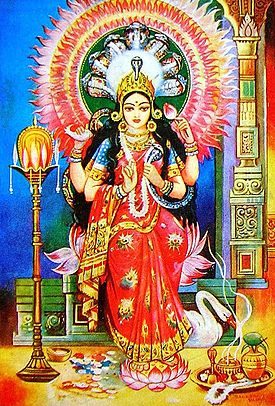
Manasamangal Kavya
Encyclopedia

Manasa
Manasa is a Hindu folk goddess of snakes, worshipped mainly in Bengal and other parts of northeastern India, chiefly for the prevention and cure of snakebite and also for fertility and prosperity. Manasa is the sister of Vasuki, king of Nāgas and wife of sage Jagatkāru...
established her worship in Bengal
Bengal
Bengal is a historical and geographical region in the northeast region of the Indian Subcontinent at the apex of the Bay of Bengal. Today, it is mainly divided between the sovereign land of People's Republic of Bangladesh and the Indian state of West Bengal, although some regions of the previous...
by converting a worshipper of Shiva
Shiva
Shiva is a major Hindu deity, and is the destroyer god or transformer among the Trimurti, the Hindu Trinity of the primary aspects of the divine. God Shiva is a yogi who has notice of everything that happens in the world and is the main aspect of life. Yet one with great power lives a life of a...
to her own worship. Manasa was a non-Aryan deity and her worship was an ancient one in Bengal. It is believed she came to Bengal with the Dravidians who worshipped her in the hope that she would protect them against snakes. Manasa
Manasa
Manasa is a Hindu folk goddess of snakes, worshipped mainly in Bengal and other parts of northeastern India, chiefly for the prevention and cure of snakebite and also for fertility and prosperity. Manasa is the sister of Vasuki, king of Nāgas and wife of sage Jagatkāru...
is also known as Bisahari, Janguli and Padmavati
Padmavati
-Mythology:* Alamelu, aka Padmāvatī, Hindu goddess and consort of Sri Venkateshwara of Tirupati* Another name for the Hindu serpent goddess Manasa* Padmavati , Jain goddess-Given name:...
.
Story
The story of Manasamangal begins with the conflict of the merchant Chandradhar or Chand Sadagar with Manasa and ends with Chandradhar becoming an ardent devotee of Manasa. Chandradhar is a worshipper of Shiva, but Manasa hopes that she can win over Chand to her worship. But, far from worshipping her, Chand refuses to even recognize her as a deity. Manasa takes revenge upon Chand by destroying seven of his ships at sea and killing his seven sons. Finally, Behula, the newly-wed wife of Chand's youngest son Lakhindar, makes the goddess bow to her love for her husband through her strength of character, limitless courage and deep devotion. Behula succeeds in bringing Chand's seven sons back to life and rescuing their ships. Then only does Behula return home.Manasamangal is basically the tale of oppressed humanity. Chandradhar and Behula have been portrayed as two strong and determined characters at a time when ordinary human beings were subjugated and humiliated. The epic brings out the caste divisions and the conflicts between Aryans and non-Aryans. The conflict between human beings and the goddess brings out the social discriminations of society, as well as the conflict between Aryans and non-Aryans. Shiva, whom Chand worshipped, was originally not an Aryan god, but over time was elevated to that position. Manasa's victory over Chand suggests the victory of the indigenous or non-Aryan deity over the Aryan god. However, even Manasa is defeated by Behula. The poem thus suggests not only the victory of the non-Aryan deity over the Aryan god, but also the victory of the human spirit over the powerful goddess. Manasamangal is also remarkable for its portrayal of Behula who epitomises the best in Indian womanhood, especially the Bengali woman's devotion to her husband.Poets of Manasamangal Kavya
The earliest poet of this genre of medieval Bengali literature was probably Kana Haridatta (c. 13th century), but his work is no longer extant. His name is found in both the works of Bijay Gupta and Purushottam. Other poets who composed versions of Manasamangal after him were PurushottamPurushottam
Purushottam is called moolapurush of kudaldeshkar Dhananjay gotri, Bharadwaj Gotri and sankhyan gotri.Purushottam means ideal man. But this Purushottam is just a noun of a person who was devotee of Lord Shiva....
, Narayan Deb (c 15th century), Bijay Gupta and Bipradas Pipilai
Bipradas Pipilai
Bipradas Pipilai , was a 15th century poet. He was the son of Mukunda Pipilai, the family hailed from Badurya-Batagram in 24 Parganas, now in the Indian state of West Bengal.-The Manasa Vijay:...
. Bijay Gupta's Manasamangal (or Padmapuran) (1484-5) is perhaps the most popular of these versions because of its rich literary qualities. Bipradas Pipilai's Manasabijay (1495-6) was also composed during the same period. Narayan Deb's work is also known as Padmapuran.
Ketakadas Kshemananda (c.17th century), Jagajjiban Ghoshal (c.17th century) and Jibankrishna Maitra (c.18th century) were later poets of this genre.
See also
- Mangal-Kāvya
- Chaitanya BhagavataChaitanya BhagavataThe Chaitanya Bhagavata is a hagiography of Chaitanya Mahaprabhu , the famous Vaishnava saint, written by Vrindavana Dasa Thakura . It was the first full-length work regarding Chaitanya Mahaprabhu written in Bengali language and documents his early life and role as the founder of the Gaudiya...
- TulsidasTulsidasTulsidas , was a Hindu poet-saint, reformer and philosopher renowned for his devotion for the god Rama...
- BhaktiBhaktiIn Hinduism Bhakti is religious devotion in the form of active involvement of a devotee in worship of the divine.Within monotheistic Hinduism, it is the love felt by the worshipper towards the personal God, a concept expressed in Hindu theology as Svayam Bhagavan.Bhakti can be used of either...
- Bengali literatureBengali literatureBengali literature is literary works written in Bengali language particularly from Bangladesh and the Indian provinces of West Bengal and Tripura. The history of Bengali literature traces back hundreds of years while it is impossible to separate the literary trends of the two Bengals during the...

